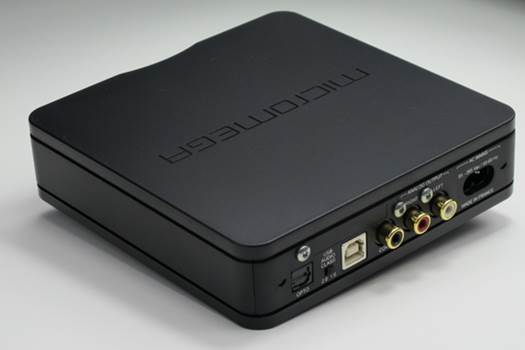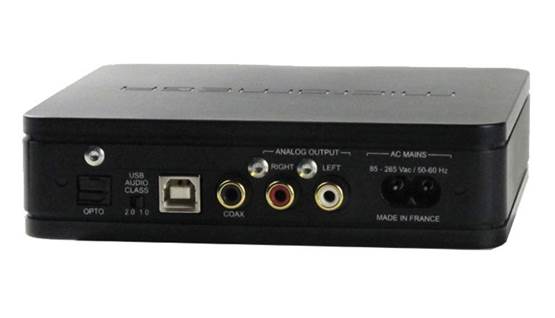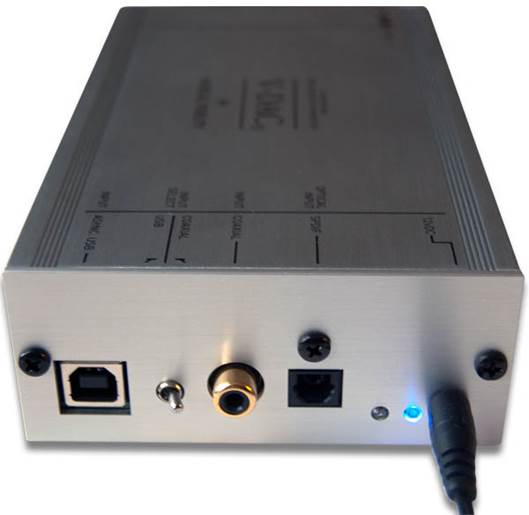Micromega MyDAC: $559
The penultimate DAC on our Super test list
comes from French manufacturer Micromega. The Micromega MyDAC is part of the
company’s new ‘My’ range of compact and affordable audio components – a line-up
which will also include an MM/MC phonon amplifier, a headphone amplifier and a
wireless streamer, among others.
But first, the MyDAC – unleashed at the
2012 High End Show in Munich, the device is designed and built in France. The
compact box comes in a matt-black (as in our review sample) or a glossy white
finish. It’s a surprisingly light box, weighing just 300g. That’s the same as
the smaller Arcam rPAC, but the Micromega MyDAC doesn’t quite have the same
premium, weighty quality of build and finish as rivals like the Arcam.

Great
for that punchy beat-based album; not so hot for your gentle chill-out
collection
We’d also be careful when connecting up the
MyDAC with the rest of your system, as we found that heavy cables can drag on
the light box and move it out of position. The rear panel houses all the
connections, which include the mains power, a pair of line-level RCA outputs,
digital optical, coaxial and type B USB inputs. On the front, there’s an
anodized aluminum rotary wheel: turn it to switch between standby mode, and the
USB, coaxial or optical inputs.
The asynchronous USB design ensures low
jitter levels and allows playback of 24 bit/192kHz files, while a switch at the
rear panel gives you a choice of USB 1.0 or 2.0 operations. This is a nice
touch from Micromega, as not all computer drivers are compatible with the class
2.0 option (which allows for high-resolution 24-bit/192kHz files), and the
class 1.0 option (up to 96 kHz) ensures better compatibility. Two USB master
clocks inside are aimed at reducing jitter levels.

The
asynchronous USB design ensures low jitter levels and allows playback of 24
bit/192kHz files, while a switch at the rear panel gives you a choice of USB
1.0 or 2.0 operations
Pace and punch aplenty
Start playing some tracks from a laptop and
the Micromega delivers clear and punchy notes. Select Elephants by Them Crooked
Vultures and the MyDAC drives the tune along with plenty of energy, fully
conveying the grungy, attacking sound. There’s solid weight to all the
instruments, while decent dynamics and timing work effectively together to
produce a fast-paced and exciting performance – just what the track needs.
There is a slight hardness and brightness
to the edge of notes, however – rather like the Audio quest DragonFly – which
means tracks that thrive on excitement and attack pair up well with the MyDAC,
whereas gentler pieces of music have an unnaturally hard edge to them (as
witnessed on a WAV recording of Amanda Palmer’s The Bed Song).
There’s solid weight to instruments,
while decent dynamics and timing work together to produce a fast paced and
exciting performance

Start
playing some tracks from a laptop and the Micromega delivers clear and punchy
note
It’s an approach that the MyDAC lends to
all types of music, and it’s hard to ignore. From streaming to the high
resolution 24-bit/192kHz files, there’s an obvious jump in quality, but the
Micromega’s tonal character lingers. Beethoven’s Piano Concerto No 3 (in
24-bit/192kHz) could do with more layers of detail and melody wrapped around it
for a more involving listen.
The Micromega MyDAC falls just short of
being an all-round wonder, then. But don’t let that deter you: this DAC has heaps
of energy and attack.
Rating: 4/5
For: Attacking sound; good timing; exciting
performance; USB playback of 192 kHz files
Against: Not the most subtle of performers;
can sound a bit too hard and bright
Verdict: If you like your music to have an
attacking edge, then this DAC’s for you
Micromega MyDAC specs
·
USB in: 1
·
Coaxial digital in: 1
·
Optical digital in: 1
·
RCA in: 0
·
RCA out: 1
·
XLR out: 0
·
Optical digital out: 0
·
Coaxial digital out: 0
·
Headphone: 0
·
Wireless: No
·
Finishes: 2
·
Dimensions (H x W x D): 3 x 14 x 14cm
·
Performance: 4
·
Feature: 4
·
Build: 3
Musical Fidelity V-DAC II: $451
The dust had barely settled on the V-DAC II
from its first test when the unit was back out to do battle with its peers as
part of this Super test.
The Mk II version of Musical Fidelity’s
V-DAC made a favorable impression when we first listened to it. That’s because
it shines with a clean and clear sound, and offers a good helping of detail
mixed in with some fluid and smooth dynamics that keeps you engaged with the
music.

Clarity
gets the nod over weight – both musical and physical – on the V-DAC II
Like the Arcam rDAC, this USB device has a
sweet, melodic touch across the frequencies, with the mid and top ranges
getting particular attention. Whether you’re listening to Norah Jones, Nelly
Furtado or Josh Homme, their voices sound natural and sparklingly clear.
There’s plenty of space for high notes to thrill on an open soundstage, but
they never sound thin or harsh.
In terms of outright attack and aggression,
the V-DAC II has a more polite and refined presentation. In comparison, the
Micromega and rDAC have much more weight and solidity to anchor the music down,
and lend it a stronger and punchier performance. As it stands, the V-DAC II’s
smooth and sweet sound can come across as slightly insubstantial. There’s no
bright or brittle treble to be found, but more muscular and deeper lower
frequencies would’ve given the V-DAC II a fuller and richer sound. Take
Beethoven’s Moonlight Sonata in 16-bit/44.1kHz – the music ebbs and flows with ease,
but we’d love to hear a touch more precision and robustness to the piano notes.
Compact dimensions
Cosmetically, the V-DAC follows in the
footsteps of the rest of the products in the company’s V-Series: the DAC is a
half-width design in a solid casing that’s finished in brushed silver. It’s
compact enough not to disrupt the neatness of any desk, and surprisingly light
in weight given its appearance of quality.
On the inside, there’s a Burr Brown DSD
1796 DAC chip, and the asynchronous USB design of the V-DAC II aims to reduce
any timing errors that hampers music played from a computer, and allows for
playback of high-resolution files up to 24 bit/192kHz.

On
the inside, there’s a Burr Brown DSD 1796 DAC chip, and the asynchronous USB
design of the V-DAC II aims to reduce any timing errors that hampers music
played from a computer
Unlike most conventional designs where the
connections are all hidden away on the rear panel, the inputs and outputs are
situated on the right and left sides of the V-DAC respectively. RCA outputs to
connect the DAC to your stereo amplifier feature on one side, while the mains
power connection and coaxial, optical and type B USB inputs are neatly spaced
out on the other. The coaxial input can handle files up to 24-bit/192kHz, while
the optical and USB inputs go up to 24-bit/96kHz.
Smooth and engaging
While the V-DAC II’s smooth aural
presentation may not be for those who favor a more attacking and punchy style
(they should, perhaps, look to the Micromega MyDAC), its wonderfully clear and
musical approach, together with its engaging dynamics, will win over many other
listeners.
Take Beethoven’s Moonlight Sonata in
16-bit/44.1kHz, and the music ebbs and flows with ease, but we’d love to hear a
touch more precision
Rating: 4/5
For: Fluid dynamics; smooth and refined
detail; very clear sound; compact build
Against: Could do with more weight and
precision; no headphone output
Verdict: We love the way the V-DAC II
delivers its clear and dynamic performance
Musical Fidelity V-DAC II specs
·
USB in: 1
·
Coaxial digital in: 1
·
Optical digital in: 1
·
RCA in: 0
·
RCA out: 1
·
XLR out: 0
·
Optical digital out: 0
·
Coaxial digital out: 0
·
Headphone: 0
·
Wireless: No
·
Finishes: 1
·
Dimensions (H x W x D): 10 x 17 x 4cm
·
Performance: 4
·
Feature: 4
·
Build: 4